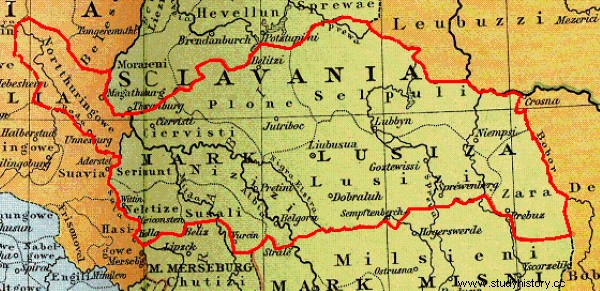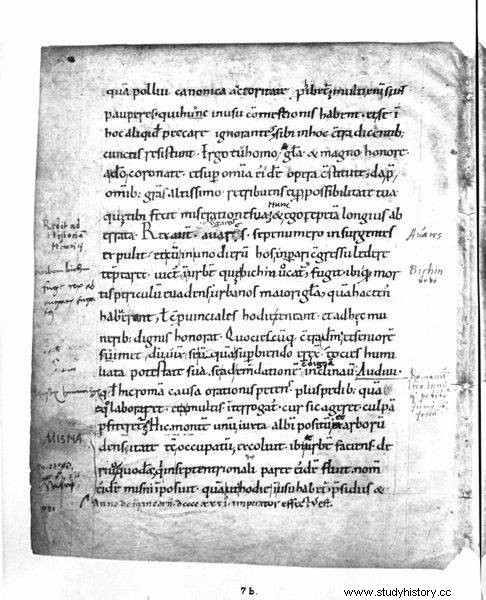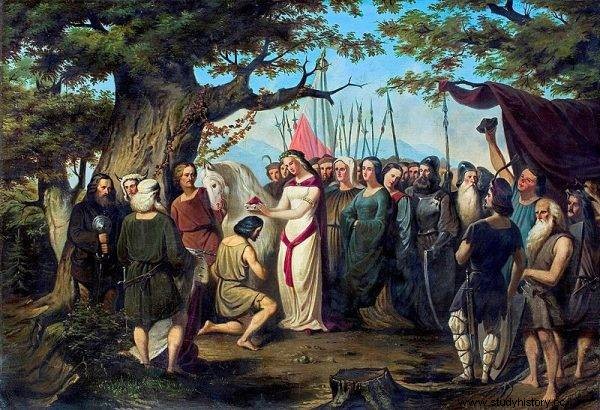"Meanwhile, the noble margrave Hodo, having gathered the army, attacked Mieszko with him (...). Only my father, Count Zygfryd, a young man at the time and not yet married, rushed to help the margrave (...). When on St. John the Baptist clashed with Mieszko, won at first the victory, but then in a place called Cidini, his brother Czcibor defeated them, laying down all the best knights, except for the aforementioned graphs, 'wrote the Bishop of Merseburg Thietmar. And although the first victorious battle of the Polish army with Germany entered the pantheon of our national myths, at that time ... no one actually heard about it.
It is known that such a battle took place, and although it actually happened to be in Thietmar's chronicle because his father took part in it, it was not a result of fate. The German Drang nach Osten made the armed troops of Roman emperors of the German nation to base themselves on the borders of the Polan state in the 60s of the 10th century. The bloody - and consequently victorious - struggles of Mieszko I with the Wielets commanded by the rebel against Otto I, Count Wichman, could not go unnoticed in the Reich.
Nevertheless, the war with the recalcitrant grapheme did not worsen the relations between the ruler of Polan and the emperor himself. The provisions of the agreement concluded earlier between Mieszko and Otto were still in force, thanks to which our prince was included among the friends of the German ruler. So if it was so good, what was the reason for the armed meeting at Cedynia? Well, that's not the only question mark in the story…
But why?
The scientific literature generally did not attempt to explain the reasons for the invasion of Hodon, the margrave of the Lusatian Marches. The reason was and is extremely simple - lack of sources. However, there were also researchers who nevertheless tried to explain it.
And so, according to some, Hodon's expedition was a personal undertaking of the margrave or an attempt to prevent Mieszko I's attempts to emancipate himself from German sovereignty. In turn, others saw the sources of intervention in the dispute over the tributary territory of Lubusz, over which the Polish prince gained sovereignty, and Hodo wanted to act in this area due to the supervision over the area. In the end, it was also suspected that the margrave's raid was agreed with his superior, Theodoric, and was aimed at stopping Mieszko's expansion into Western Pomerania, which could endanger the interests of the Reich.

Margrave Hodo ruled in the Lusatian March - far from the alleged site of the Battle of Cedynia.
After all, there are many indications that the margrave of the Lusatian March Hodon was a typical "hawk" of his time, looking only for an opportunity to attack his victims - the Slavs. The successes of the Polish prince probably worried him. His growing neighbor could be a serious threat to the realization of even his personal Drang nach Osten.
Therefore, probably without the consent of the emperor - as indicated by Thietmar's record that:"The emperor, moved to the living by the news of this defeat, sent messengers, ordering Hodon and Mieszko to remain calm under pain of losing his grace until he arrives at the place and personally examines matter ”- he started a private war with the ruler of Polans.
Which way to Cedinia?
Extremely sparse and imprecise source reports about the battle also prevent us from accurately determining the place where it was fought. According to today's translation of Thietmar's chronicle, the clash took place "in a place called Cidini." Historians, however, suggest that the chronicler did not mean a specific town, but more about a place - perhaps a castle, a settlement or a forest or a ford on a river. For centuries, attempts have been made to fill this understatement with a specific location. Thus, the battle was to take place near Szczecin or at Zehdenick on the Hobola River (today Havela) 60 km north of Berlin or south of Berlin at Zeuthen.
Of course, today's Cedinia in Western Pomerania was also taken into account, if, as researchers claim:"[...] this town did not lie so far to the north [and] if there were no old Slavic villages in this area with names such as Zithen or Sithen ”- which can be equated with Thietmar's“ Cidini ”. Other studies indicate, in turn, that regardless of the chronicle's location, the battle was not fought at any Cedynia. There is more talk about some Sidzina, Seat, or Szczytno or Sitna.
The historians' dispute over the place of the battle is additionally fueled by the fact that today's Cedynia is far away from the territory under the rule of margrave Hodon, whose center was Lusatia - thus much more to the south of the theater of those military operations. Which, in turn, would require the Hodon regiments to make a new way through the lands of one of the rival margraves. Besides, as some researchers emphasize, neither Mieszko nor his adversary "in all probability had nothing to look for there".

The Battle of Cedynia was actually included in Thietmar's chronicle records (one of the pages of his Chronicle in the photo), because his father participated in it.
Doubts about the mysterious Cidini were dispelled with one political cut after 1945. In the post-war reality, the myth of Cedynia, where prince Polan and his brother defended Polish lands against the German Drang nach Osten, turned out to be so useful that he began to live his own life in complete isolation from enigmatic chronicle records.
Great battle?
Just as little is known about the causes of the clash, we also do not know its exact course. Interestingly - even though Thietmar devoted one sentence to him, and the second (about which later), even more general, was the work of Bruno of Querfurt, military historians are still able to speculate and discuss the preparations and the course of the battle to this day. A battle that did not really get much publicity in the 10th century. Thietmar and Brunon hardly mentioned her. And in other known chronicles there is a deafening silence, which would probably be unthinkable if hundreds of Reich warriors died in the confrontation with the Slavs.
Therefore, there is a thesis that the Battle of Cedynia was more of a skirmish in which both sides had small, hastily formed troops. It is also suggested that the superiority in numbers and armaments was on the side of the margrave's army, and Mieszko faced it without preparation, with the forces at hand.
Some researchers assume, however, that the forces of both sides were even, reaching 4–4.5 thousand. armed . Probably the Lusatian margrave had more heavy cavalry, while the strengths of Mieszko were archers and infantry - the famous shield-bearers. The advantage of our prince was also a good knowledge of the area and efficient reconnaissance, which learned about the movements of the enemy troops in advance.
According to the researchers' guesswork, Mieszko was to divide his forces into three divisions. The first one, commanded by the ruler himself, was to block the crossing of the Odra River on the road leading to Cedynia. And here is a curiosity worth emphasizing - in the casual description of the battle, Thietmar did not even mention the river spreading over several kilometers at the foot of the Cedynia hillfort. It is hard to believe that the chronicler was silent about such a huge obstacle on the path of the Hodon regiments, the more so because they would have to cross it twice - attacking Mieszko's positions for the first time, and escaping from his brother Czcibor for the second time. Of course, the historians' carelessness cannot be completely ruled out, but this additionally calls into question the location of the battle.

In the first phase, the troops of Hodon and Siegfried were to attack the troops of Mieszko I, forcing them to withdraw towards Cedynia.
Returning, however, to the supposed division of the troops of the Duke of Polans - the other two groups, led by the prince's brother, partially strengthened the castle's crew and were hidden behind the hills above the road to Cedynia, adjacent to the marshes around the old Odra river bed.
The battle took place on June 24, 972, and had two phases - these are the only certain details in this enigmatic story. However, we are still dealing with a festival of guesswork.
In the first phase, the troops of Hodon and Zygfryd were to attack the troops of Mieszko I, forcing them to withdraw towards Cedynia. It is suspected that the retreat maneuver was planned in advance to ambush the enemy . The battle at the crossing must have been hard, however, since it made the margrave's warriors seem victorious - as mentioned by the Merseburg chronicler.
The Saxons, drunk with the success, began a march deep into the area. Their troops and the rolling stock stretched out into a long column on a narrow road that was squeezed between the hills and the muddy banks of the Odra River. Some researchers suspect that the head of Hodon's column reached Cedynia and broke into the borough. At this point, the second phase of the battle began - Czcibor's troops closed the enemy's way of retreat and attacked from the side of the hills. The forces of the town's garrison with the previously withdrawn soldiers of Mieszko were also to start the fight.
Margrave's troops found themselves in a bloody cauldron. As a result, as another chronicler recalling the battle of Cedynia, Brunon of Kwerfurt, wrote:"[...] the militant margrave Hodo with torn banners rushed to flee". As we know, Thietmar's father, Count Zygfryd, also survived. We know nothing about the other victims, especially their number.
It is assumed that the Saxon losses in such a clash must have been considerable. The scale of casualties on the part of Mieszko's army is also unknown. It is customary to assume that they were much smaller than the invaders. After all, military historians emphasize the high level of military art of the prince's army, which, according to the preacher from Querfurt, "won with art", and "the Teutons' humiliated pride had to lick the ground."
Who is to blame?
Although Mieszko did not take any offensive steps and did not move the war to the territories of the Reich, Emperor Otto I decided to prevent the future of such actions on the part of the ruler of Polans, who grew in strength. Probably still in 972 the matter of the conflict was brought before the imperial court.
Although the exact content of the judgment is unknown, we can nevertheless guess its meaning. It was considered that Margrave Hodo had every reason to engage in combat, as he retained the office of margrave until his death in 993. Thus, Mieszko I was found guilty of initiating the war. The Duke kept the Pomeranian gains, but was forced to send his son, Bolesław, to the imperial court as a hostage. It was supposed to be a kind of guarantee that, at least in the near future, no actions would be taken against the interests of the Reich and that the borders of the Empire would not be violated.
